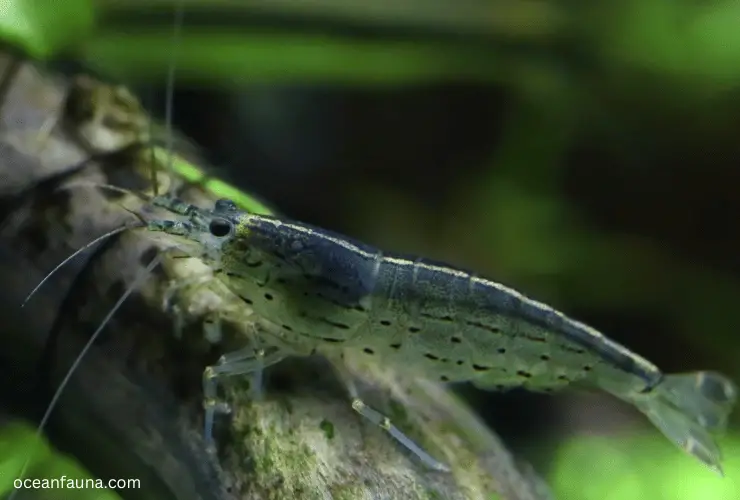Amano Shrimp are originally from Japan, Taiwan, Korea, and some parts of China and can be found in streams and rivers. They can adapt to various water temperatures between 64°F to 86°F, yet they prefer cooler waters that contain a lot of dissolved oxygen.
If you believe that Amano Shrimp are only freshwater creatures, then you are mistaken, as the young ones can be carried down to full saltwater through streams. In this article, I will discuss, in detail, the habitat, diet, anatomy, and other facts of Amano Shrimp.
About: Amano Shrimp
Amano Shrimp, also known as Yamato Shrimp, are a species of freshwater shrimp that are native to Japan, as well as parts of Korea and Taiwan. They are highly sought after by hobbyists due to their striking appearance and their ability to help maintain a healthy aquatic ecosystem.
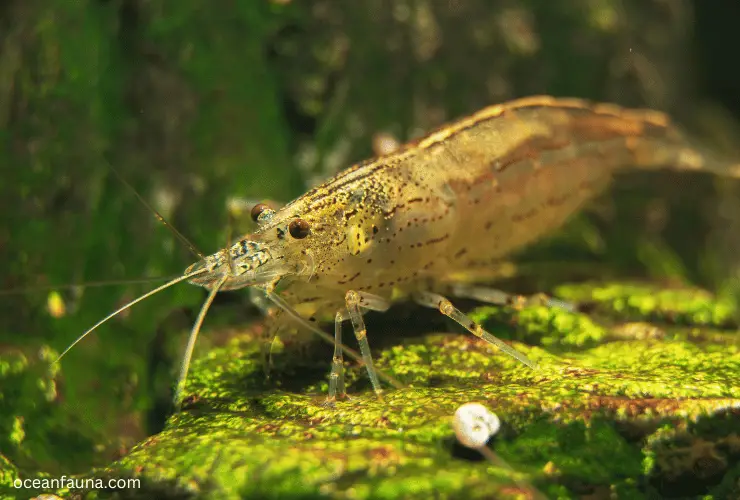
However, breeding Amano shrimp in captivity is very difficult, so most of the shrimp available in pet stores are caught in the wild. Amano shrimp are born in freshwater, but in order to grow and develop properly, they require a gradual transition to brackish water and eventually full saltwater.
One interesting behaviour of Amano shrimp is their tendency to eat their old exoskeleton after moulting. This provides them with important minerals that they need for healthy growth and development.
While the adults live in freshwater, they breed in freshwater as well. However, once the young are released, they are swept downstream into full saltwater. Because of this unique life cycle, it is important for hobbyists to carefully consider the water conditions and environmental factors in their tank to ensure that the Amano shrimp can thrive.
In addition to their aesthetic appeal, Amano shrimp are also valued for their ability to help keep aquariums clean. They are known to eat algae and other organic matter, which can help prevent issues like algae blooms and poor water quality.
| Category | Information |
| Scientific Name | Caridina multidentata |
| Diet | Omnivorous – algae, biofilm, decaying plant matter, and small invertebrates. |
| Habitat | Freshwater rivers, streams, and swamps in Japan, Taiwan, and other parts of East Asia. |
| Size | Adults reach around 2 inches (5 cm) in length. |
| Lifespan | Typically live for about 2-3 years in captivity. |
| Interesting Facts | 1. Amano Shrimp, also known as Yamato Shrimp or Japonica Shrimp, were named after the renowned aquarist Takashi Amano who popularized them in the aquarium hobby. 2. They are often used in aquariums as algae eaters and are highly valued for their ability to control algae growth. 3. Amano Shrimp are excellent escape artists and can climb out of open aquariums if the conditions are not suitable for them. 4. They are known for their intricate and elaborate feeding behavior, which includes picking at surfaces and filter feeding. 5. These shrimp have a transparent or lightly colored body with distinctive reddish-brown markings, making them visually appealing in aquarium setups. |
Anatomy of Amano Shrimp
Shrimp are fascinating invertebrates that share distinct characteristics that adapt them to various aquatic environments. This section will provide in-depth information about the Amano shrimp’s anatomy, which comprises several intricate systems.
Exoskeleton
One of the most distinguishing features of Amano shrimp is their exoskeleton, a hard and clear shell covering the outside of their bodies. The exoskeleton protects from predators, injury, and damage from the environment. It consists of several layers: the thick outer layer, the middle prismatic layer, and the innermost membranous layer.
Cephalothorax
The cephalothorax is the first segment of the shrimp’s body and is a fusion of the head and thorax. It contains all the sensory and feeding organs, including the eyes, antennae, mouth, and mandibles. The powerful muscles located in this segment allow the shrimp to swim, crawl, and move around with agility.
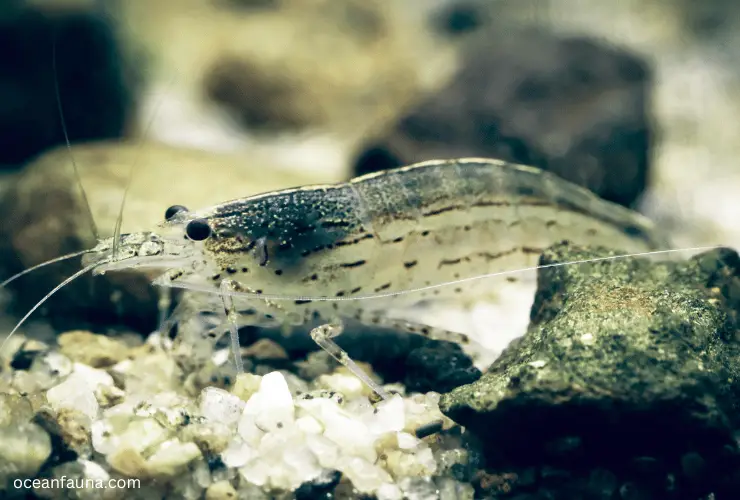
Abdomen
The abdomen is the second segment of the shrimp’s body and houses its reproductive and digestive systems. The abdomen is soft, flexible, and segmented and contains several appendages that help with movement, feeding, and reproduction, such as pleopods, uropods, and swimmerets.
Respiratory System
Shrimp have a unique respiratory system that allows them to breathe underwater. Depending on the species, they absorb oxygen through gills located on the pleopods or the thoracic region. The gills extract oxygen from the water and release carbon dioxide, allowing the shrimp to respire.
Digestive System
Amano shrimp have a well-developed digestive system that allows them to extract nutrients from their food. The mouth of the shrimp is located on the underside of the cephalothorax and contains a set of mandibles that help crush and grind their food. The digestive system includes the oesophagus, stomach, and intestine, where digestion and absorption take place.
Muscular System
Shrimp have a complex muscular system that allows them to move around, swim, and perform other important functions. The powerful muscles, which are distributed throughout the body, contract and relax to allow the shrimp to move its exoskeleton and appendages. The muscular system works in tandem with the nervous system to receive signals and coordinate movements.
How Does Amano Shrimp Get Its Name?
Amano shrimp derive their name from the legendary aquarist Takashi Amano, who was instrumental in popularizing these crustaceans in the aquarium hobby. Takashi Amano was a renowned nature photographer and an avid aquarist who is famous for his innovative approach to aquarium design and hardscaping.
In the late 1980s, Takashi Amano discovered that Amano shrimp (also known as Caridina multidentata) could remarkably control algae growth in aquariums. This unique ability made them highly sought-after by aquarists, as they helped maintain a healthy aquatic environment in their tanks. They were especially useful for keeping tanks with live plants clean, as they didn’t harm the plants while consuming the algae.
Takashi Amano quickly recognized the potential of these shrimp and began breeding them, which led to their widespread availability in the hobby. Amano shrimp was named after him as a tribute to his pioneering work with these crustaceans.
These shrimp are now considered an important addition to any aquarium as they not only serve as excellent algae eaters but also add to the overall aesthetics of the tank. Their distinct markings and active behaviour captivate viewers’ attention, making them a popular choice among aquarists.
Where Do Amano Shrimp Live?
Amano shrimp, also called Yamato Shrimp, is a species that originates from Japan and can also be found in certain regions of Korea and Taiwan. They are primarily found in the wild, as breeding them in captivity is extremely difficult. These shrimp have a complex life cycle involving three types of water: freshwater, brackish water, and saltwater.
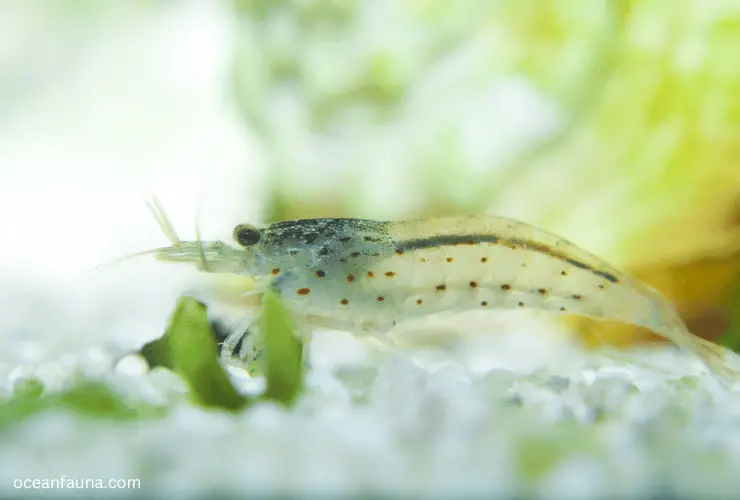
Adult Amano shrimp live in freshwater habitats like rivers and streams. However, they require brackish water to breed successfully. Brackish water is a mix of freshwater and saltwater, typically found where a river meets the ocean.
Female Amano shrimp release fertilized eggs into brackish water and hatched larvae, then enter saltwater, where they grow and develop until they are ready to return to freshwater as adults.
Amano shrimp have a wide distribution range and can be found in various freshwater habitats around Japan, Korea, and Taiwan. In their natural habitats, Amano shrimp play an important role in maintaining the ecological balance by acting as scavengers, feeding on algae and other organic debris.
Unfortunately, due to the high demand for Amano shrimp for use in aquariums, wild populations are at risk of overfishing, which can negatively impact the ecosystem.
What Does Amano Shrimp Eat?
Amano shrimp are known for being voracious algae eaters and consume a wide variety of different types of algae. Aquarium enthusiasts highly prize these small crustaceans for their ability to keep tanks clean and free of unsightly algae growth.
In the wild, Amano shrimp feed mainly on algae and other small organisms that they scavenge from the bottom of rivers and streams. They are opportunistic feeders and will eat whatever they can find, including detritus, decaying plant matter, and small invertebrates.
In aquariums, Amano shrimp often require additional food sources beyond just algae. Most commercially available shrimp foods will suffice, but they must supplement their diet with fresh vegetables like zucchini, spinach, and cucumber.
Some hobbyists even feed their Amano shrimp-dried algae sheets, which can be purchased at most pet stores.
Regarding nutritional needs, Amano shrimp require a balanced diet that provides sufficient protein, carbohydrates, and other essential nutrients. Avoid overfeeding, as excess food can lead to water quality issues and other health problems.
Amano shrimp are generally hardy and adaptable and can thrive in various water conditions if their basic nutritional needs are met.
How Long Do Amano Shrimp Live?
Amano shrimp, or Caridina multidentata, are sturdy creatures that can adapt to various water conditions. In their native habitat, they are found in freshwater streams and rivers of Japan. In the wild, their life expectancy is usually shorter than in captivity due to environmental factors and predation.
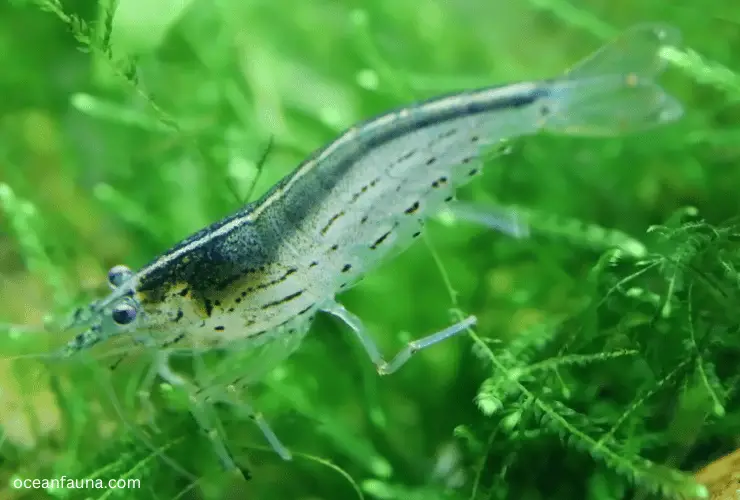
In aquariums, Amano shrimp can live up to four years if they are kept in good condition. Proper care involves maintaining stable water parameters, providing a balanced diet, and avoiding overcrowding.
Water temperature, pH levels, and hardness can affect their overall health and lifespan. The ideal water temperature for Amano shrimp is between 64-80°F, with a pH range of 6.0-7.5 and water hardness between 4-6 KH.
How Do Amano Shrimp Reproduce?
Amano shrimp are freshwater crustaceans that reproduce sexually through internal fertilization. Breeding takes place after the female moults and releases pheromones into the water column to attract males. The males will then locate the female and engage in mating.
Following fertilization, the female will carry the fertilized eggs in her pleopods/swimmerets until they hatch. The eggs will remain attached to the female’s swimmerets, where they will develop and mature. The number of eggs produced can range from 1000-3000, and they will be visibly present as a green colouration on the hind of the shrimp.
Depending on the water temperature and conditions, it may take up to 5 weeks for the eggs to hatch. Upon hatching, the baby shrimp will be fully formed and will resemble miniature versions of adult Amano shrimp. The larvae will initially feed on plankton before transitioning to a more varied diet.
Amano shrimp are not particularly prolific breeders, and their slow reproductive rate has led to concerns about the sustainability of wild populations. Efforts to conserve and protect the species have included captive breeding programs and regulations limiting the export of wild-caught shrimp.
What Eats Amano Shrimp?
Amano shrimp are small invertebrates that are often preyed upon by a variety of aquatic predators. Predatory fish such as goldfish, bettas, and Oscars are known to attack and eat Amano shrimp. These larger fish are attracted to the shrimp’s small size and appetizing appearance, making them a vulnerable target for predation.
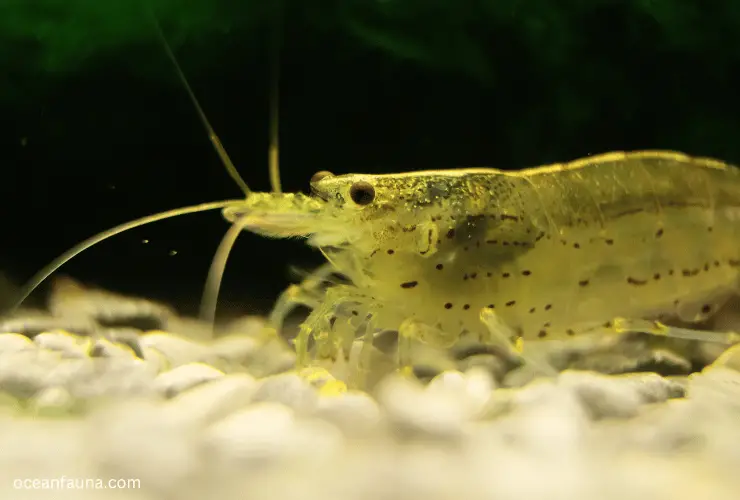
In addition to larger fish, other aquatic animals, such as crayfish or freshwater lobsters, are also known to prey on Amano shrimp. These larger shellfish are equipped with powerful claws that are capable of snatching up even the quickest shrimp.
Pet amphibians such as African dwarf frogs may also threaten Amano shrimp. These frogs are known to feed on various small aquatic animals, including shrimp. They are highly skilled hunters and can quickly snatch up unsuspecting shrimp with their long, sticky tongues.
To keep your Amano shrimp safe, you should keep them away from other aquatic animals that might prey on them, especially if you have predatory fish. You can keep them in a separate tank or provide them with a safe habitat to protect them from predators. This way, you can ensure the safety and well-being of your Amano shrimp.
Can Amano Shrimp Carry Diseases?
Yes, Amano shrimp can carry diseases. They are susceptible to a range of bacterial and fungal infections and parasitic infestations. Various factors, such as poor water quality, inadequate diet, stress, and other environmental factors, can cause these diseases.
Also, Amano shrimp are at risk of poisoning, which can be caused by exposure to insecticides in the air or aquarium plants that have not been rinsed well enough. When this happens, the shrimp quickly turn white or pink, lose coordination, and become immobile at the bottom of the tank. Unfortunately, there is no cure for poisoning, and the shrimp will die.
Some of the diseases and infections that Amano shrimp can carry are transmissible to other aquatic organisms. To prevent the spread of diseases, it is recommended to quarantine any new shrimp before adding them to an established tank.
Are Amano Shrimp Endangered?
Amano shrimp, a popular freshwater aquarium species, are not yet endangered. This was confirmed in 2011 when they were assessed for The IUCN Red List of Threatened Species and listed as Least Concern.
Despite their current classification, it is important to note that this species could still face threats to their population in the future. Factors such as habitat loss, pollution, and overfishing could potentially put Amano shrimp at risk.
However, at this point in time, there is no evidence to suggest that their numbers are declining or that they are in danger of extinction.
Amano shrimp are a resilient species that adapt to various environmental conditions. This adaptability and responsible management practices can contribute to their continued viability in the wild.
Conclusion
I hope you now have a better understanding of Amano shrimp. While they are categorized as freshwater shrimp, they spend significant time in saltwater during their growth and development.
Let me know in the comment section if you want to know more about this shrimp species.

